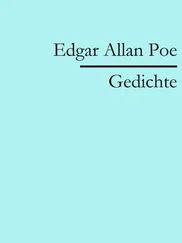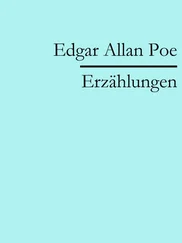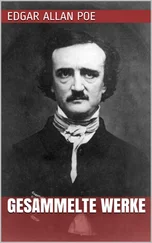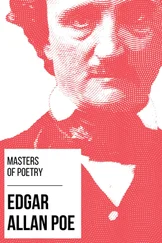Example 2.5 Finite Energy Release
A single‐cylinder spark‐ignition cycle engine is operated at full throttle, and its performance is to be predicted using a Wiebe energy release analysis. The engine has a compression ratio of 10. The initial cylinder pressure,  , at bottom dead center, is 1.0 atm, with a temperature
, at bottom dead center, is 1.0 atm, with a temperature  at bottom dead center of 300 K. The bore and stroke of the engine are
at bottom dead center of 300 K. The bore and stroke of the engine are  mm and
mm and  mm. The total heat addition,
mm. The total heat addition,  = 1764 J, and the combustion duration
= 1764 J, and the combustion duration  is constant at 40 degrees. Assume that the ideal gas specific heat ratio
is constant at 40 degrees. Assume that the ideal gas specific heat ratio  is 1.4, the molecular mass of the gas mixture is 29 kg/kmole, and the Wiebe energy release parameters are
is 1.4, the molecular mass of the gas mixture is 29 kg/kmole, and the Wiebe energy release parameters are  and
and  .
.
1 Compute the displacement volume , the volume at bottom dead center, , the dimensionless energy addition , and the mass of gas in the cylinder .
2 Plot the pressure and temperature profiles versus crank angle for −20 (Engine 1) and 0 (Engine 2).
3 Determine the effect of changing the start of energy release from −50 to +20 atdc on the thermal efficiency, and imep of the engine.
1 The displacement volume isThe volume at bottom dead center isThe dimensionless energy addition isThe mass of gas in the cylinder is
2 The above engine parameters are entered into the FiniteHeatRelease.m program as shown below. The start of energy release is for Engine 1 and for Engine 2, and all other parameters are the same for both engines. function [ ] = FiniteHeatRelease( ) Gas cycle heat release code for two engines Engine input parameters: thetas(1,1) = -20; Engine 1 start of energy release (deg) thetas(2,1) = 0; Engine 2 start of energy release (deg) thetad(1,1) = 40; Engine 1 duration of energy release (deg) thetad(2,1) = 40; Engine 2 duration of energy release (deg) r =10; Compression ratio gamma = 1.4; Ideal gas const Q = 20.0; Dimensionless total energy addition a = 5; Wiebe efficiency factor a n = 3; Wiebe exponent n ...}The pressure profiles are compared in Figure 2.19. The pressure rise for Engine 1 is more than double that of Engine 2. The maximum pressure of about 8800 kPa occurs at 11 after top dead center for Engine 1, and at about 25 after top dead center for Engine 2. The temperature profiles are shown in Figure 2.20. Engine 1 has a peak temperature of about 2900 K, almost 400 K above that of Engine 2.
3 The start of energy release is varied from to , as shown in Figures 2.21and 2.22, and the resulting thermal efficiency and imep are plotted.
Comment: The results indicate that there is an optimum crank angle for the start of energy release, which will maximize the thermal efficiency and imep. For this computation, the optimum start of energy release is about 
 , resulting in a maximum thermal efficiency of about
, resulting in a maximum thermal efficiency of about  , and imep/
, and imep/  of about 13.2. At crank angles less than or greater than this optimal angle, the thermal efficiency and imep/
of about 13.2. At crank angles less than or greater than this optimal angle, the thermal efficiency and imep/  decrease.
decrease.
Pressure profiles for Example 2.5. 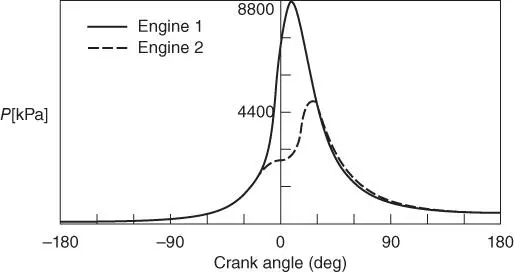 Temperature profiles for Example 2.5.
Temperature profiles for Example 2.5. 
An explanation for the optimal crank angle is as follows. If the energy release begins too early during the compression stroke, the negative compression work will increase, since the piston is doing work against the increasing combustion gas pressure. Conversely, if the energy release begins too late, the energy release will occur in an increasing cylinder volume, resulting in lower combustion pressure, and lower net work. In practice, the optimum spark timing also depends on the engine load, and is in the range of 
 to
to 
 . The resulting location of the peak combustion pressure is typically between 5
. The resulting location of the peak combustion pressure is typically between 5  and 15
and 15  atdc.
atdc.
Cylinder Heat and Mass Transfer Loss
In this section we develop simple models of the heat transfer and the mass blowby process, and include them in the energy release analysis developed in the previous section. Engines are air or water cooled to keep the engine block temperatures within safe operating limits, so there is a significant amount of heat transfer from the combustion gas to the surrounding cylinder walls. Also, internal combustion engines do not operate on closed thermodynamic cycles, rather there is an induction of fresh charge and expulsion of combustion products, and there is leakage of combustion gases or blowby past the rings, since the rings do not provide a complete seal of the combustion chamber. The blowby can affect the indicated performance, the friction and wear, and the hydrocarbon emissions of the engine.
The heat transfer to the cylinder walls is represented by a Newtonian‐type convection equation with a constant heat transfer coefficient h. More realistic models accounting for a variable hare presented in Chapter 11. The mass flow is assumed to be blowby past the rings from the combustion chamber at a rate is proportional to the mass of the cylinder contents. A useful rule of thumb is that new engines will have a 0.5% blowby, then operate for most of their life at a typical level of 1% blowby, and gradually reach a maximum blowby of 2.5–3.0% at the end of their useful life.
Читать дальше

 , at bottom dead center, is 1.0 atm, with a temperature
, at bottom dead center, is 1.0 atm, with a temperature  at bottom dead center of 300 K. The bore and stroke of the engine are
at bottom dead center of 300 K. The bore and stroke of the engine are  mm and
mm and  mm. The total heat addition,
mm. The total heat addition,  = 1764 J, and the combustion duration
= 1764 J, and the combustion duration  is constant at 40 degrees. Assume that the ideal gas specific heat ratio
is constant at 40 degrees. Assume that the ideal gas specific heat ratio  is 1.4, the molecular mass of the gas mixture is 29 kg/kmole, and the Wiebe energy release parameters are
is 1.4, the molecular mass of the gas mixture is 29 kg/kmole, and the Wiebe energy release parameters are  and
and  .
.
 , resulting in a maximum thermal efficiency of about
, resulting in a maximum thermal efficiency of about  , and imep/
, and imep/  of about 13.2. At crank angles less than or greater than this optimal angle, the thermal efficiency and imep/
of about 13.2. At crank angles less than or greater than this optimal angle, the thermal efficiency and imep/  decrease.
decrease. Temperature profiles for Example 2.5.
Temperature profiles for Example 2.5. 

 to
to 
 . The resulting location of the peak combustion pressure is typically between 5
. The resulting location of the peak combustion pressure is typically between 5  and 15
and 15  atdc.
atdc.
